






Young children possess boundless imagination, perfect openness to the world and all its beauty, and the inborn idea that anything is possible. We believe that these wonderful gifts should not fade with age.
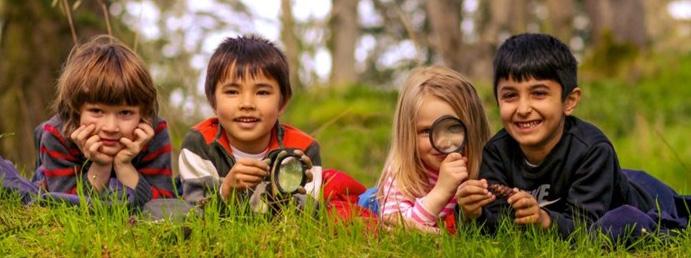




With an innovative program enriched by music, dance, theatre and visual arts, our goal is to enable children to fully explore and express these gifts in an endless variety of ways. Inspiring and nurturing today’s child firmly implants their future inner child – that playfulness, creativity, vision and confidence that will enable them to realize their dreams.
“When I examine myself and my method of thought, I come to the conclusion that the gift of fantasy has meant more to me than my talent for absorbing knowledge.”
– Albert Einstein Preschool to Grade 12 www.ArtsCalibre.ca 250-382-3533


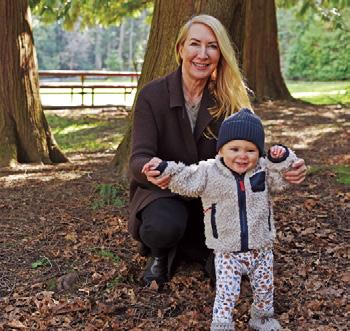




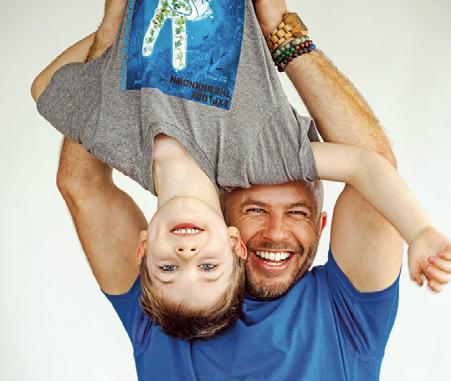


1. Give your time, skills and/or money to a good cause. Not only can this help the community but it can also improve our health, ease feelings of loneliness and broaden our social networks. Whether you go the official route through a volunteer organization or come up with ideas and charities of your own, it’s a win-win-win.
2. Instead of driving, walk or ride bikes. What better way is there to get outside and cover some ground than going for a spin? Not only is it easy on the environment but it’s also great exercise and a good way to improve mood.

3. Get creative—and involve others. A good example of this is Fernwood’s Pole Painting Project (Fernwood.ca). The installation of over 100 brightly painted telephone poles has helped slow traffic and discourage graffiti while bringing the community together and creating warm, friendly spaces.
4. Gather family, friends and neighbours. Keep it low key and informal, don’t worry about a messy house or a fancy meal, the point is to get together to enjoy each other’s company and connect despite everyone’s hectic schedules and/or the busy day-to-day.
5. Unplug. Maybe not for a weekslong digital detox, but maybe at least a few times a day. Or create some nophone and no-screen zones in your home: in bed, at meals, outdoors. Play a first-tolook game where the first person to check their phone has to wash the dishes or walk the dog.
6. Go out—outside, out on the town or out of your comfort zone. With the weather warming up, it’s easier to get outdoors, go on a road trip or try something new. Watch how your mood improves—and how that can spread to others around you.

7. Spread kindness. Hold a door open for someone, offer to help carry somebody’s groceries, drive patiently, bake for a neighbour.

8. Express gratitude. Did someone go above and beyond for you? Say so! Did something work out or fall into place? Create a family ritual of reflecting on all the good things that happen each day. Or create a gratitude journal and invite kids to add daily entries.

9. Reduce your carbon footprint. Remember Earth Day is April 22. For a Footprint Calculator and to learn about ways to walk softly on the earth, visit footprintnetwork.org.

10. Do what you love—that alone will inspire others. For work and for play, doing what we love brings us—and often those around us—joy. Better yet is doing what we love with those we love.

Volunteers are integral to invasive plants management and habitat restoration in Saanich. Share your energy with the parks you love, invest in the spirit of ecosystem restoration and build lasting relationships—all through volunteering.
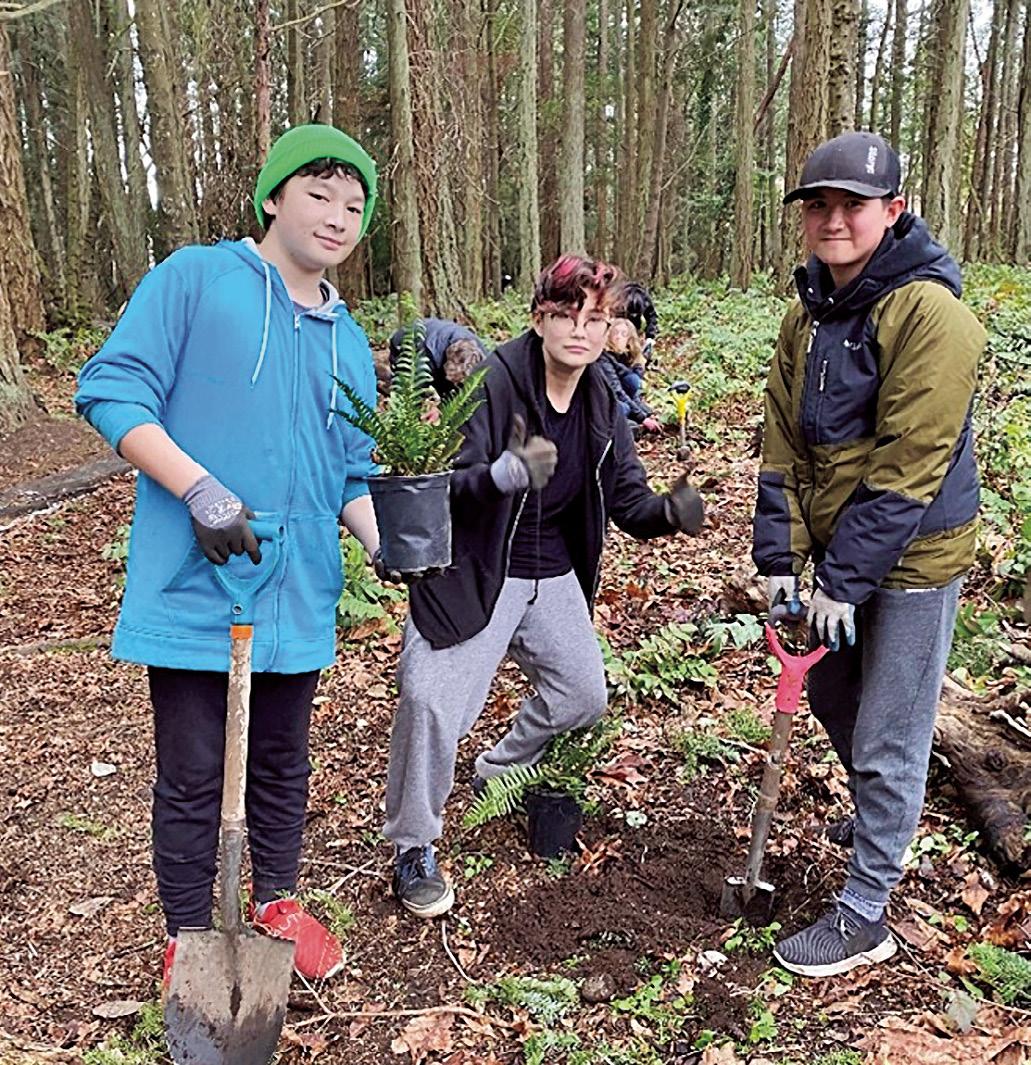
If you’re interested in getting your group involved with Pulling Together, Saanich Parks, Recreation and Community Services wants to hear from you! Neighbourhood groups, school groups, environment clubs, Scout and Guide groups, businesses and faith groups—everyone is welcome. To register as a restoration volunteer, visit saanich.ca.
Designed to raise awareness of environmental action and how we can all make a difference, Earth Day, on April 22, is your chance to get involved. In addition to raising environmental awareness among many citizens and organizations across the country, this campaign also encourages people to take action. This year the campaign will be unveiled on April 6. To find out more and how you can make a difference not only on Earth Day but every day, visit earthday.ca.


How do things work in your household? Who does the majority of the financial chores? Do you have separate bank accounts? What works well for you, and why? Your input to the conversation has incredible value because we can all do better if we know better. Money Stuff with Moms is all about answering money-related questions just like these. Peek behind the curtain to see how other moms do money with local hosts Lindsay Plumb and Meghan Chomut in their podcast Money Stuff with Moms on Spotify, Apple Podcasts and all the other podcast apps.


The Maritime Museum of BC is running their third annual fundraising campaign called “Float the Boat.” This campaign has a goal of $25,000 and will run from now to April 30. Throughout the campaign the museum will be marking milestones by filling a tank with water to float the boat higher and higher. Supporting this year’s campaign helps fund the comprehensive proposal to move the Maritime Museum into the Steamship Terminal Building, a perfect waterfront space. mmbc.bc.ca


Kids Help Phone aims to help transform Canada’s youth mental health landscape, starting with the Feel Out Loud fundraising campaign to raise $300M. It is the largest fundraising campaign supporting youth mental health in Canada’s history. The campaign is a call to action on behalf of the 8.2 million young people in Canada who need space to express their feelings with confidence, because the issues that this group faces are more complex than ever. The Feel Out Loud fundraising campaign will help ensure that young people are seen and heard 30 million times.
youtube.com/
watch?v=Z0mphDDrMfo

Can’t send Mom to a spa for Mother’s Day? Bring the spa to her!

Cordova Candle Co is an independent candle company out of Victoria. Candles are ethically produced in small batches using sustainable ingredients and packaging. Their mission is simple: to create candles with captivating scents and the best ingredients. cordovacandleco.com
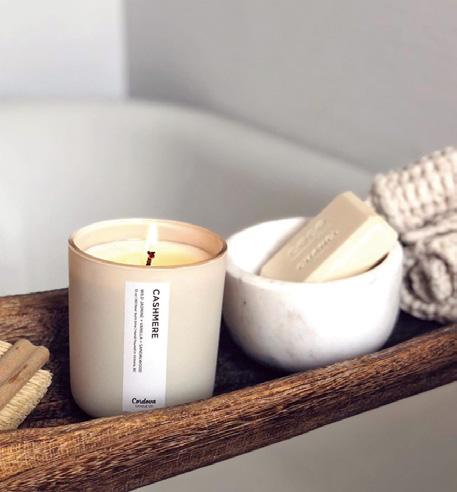
Seaflora’s Sea Silk Cleansing Oil will keep Mom’s skin barrier happy, healthy and balanced with a non-comedogenic, vegan, seaweed-infused oil cleanser. Gently dissolves makeup, sunscreen and daily grime without disturbing the skin’s natural oils or clogging pores. seafloraskincare.com
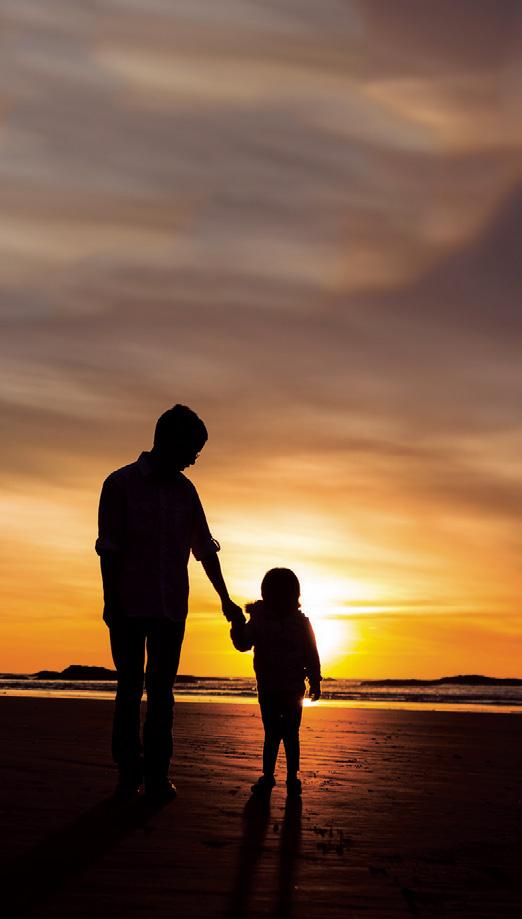



LK Cosmetics The Balm lip balm will put an end to dry, chapped lips. Get softer and more hydrated lips with this nourishing mask made with natural healing plant extracts such as Pomegranate, Blueberry, Cajupti and Centella Asiatica. Vegan, cruelty free and free of parabens and phthalates. lkcosmetics.ca
If you’re a mom or mom-to-be, I’d bet that “self-care” can be…a bit of a touchy subject. You’ve certainly heard enough about it, sometimes being told that self-care is the answer to all your challenges, or that having some alone time will do the trick.
Many moms receive the message that self-care is about pampering—spa-like bubble baths or pedicures. No wonder it’s a bit frustrating to hear that term, self-care, because it just doesn’t seem like such simple things could make much of a difference to your sense of overwhelm or exhaustion.
So let’s start with a more realistic definition. Self-care simply refers to all the things you do to help yourself feel well, including meeting your very basic needs. This can range from things like brushing your teeth, to booking a massage, to actually showing up for that pap test. Sure, your self-care routine might include a manicure, but it might also include regular counseling sessions. Self-care isn’t extra or frivolous.
Self-care refers to all the things you do to meet your needs in the different areas of your life. We’re talking emotional, physical, social, intellectual and spiritual needs. If we want to feel joy and ease, we must address our own needs so that we have the capacity to welcome those positive experiences. When we think of self-care this way, we can understand that this isn’t something you only do when your kids are asleep or with the sitter.
Self-care also doesn’t have to be so involved, difficult, and consuming. You don’t have to commit to daily workouts, frequent meditations or significantly shift your life in order for your efforts to count. It can be easy.
Self-care is essential, but our approach has to be more realistic so that it’s not just another source of stress or an un-checked item on the to-do list. It’s important to shift the conversation so that what’s supposed to support your mental well-being doesn’t become another way you feel like a failure.

Your schedule is fully booked! Timing is often the biggest obstacle that stands in the way of moms weaving self-care into their lives. You can’t find the time when it feels like a huge extra task on the to-do list. For moms struggling to find their groove in early motherhood, taking care of yourself feels like another thing you have to do. When you neglect it, it feels like another thing you’re NOT doing—and that can bring you down. So many of us see the day slip by without taking a moment for ourselves. And the
biggest mistake is thinking that self-care has to happen outside of your time with your kids. Because for many, that time is fleeting. Guilt. Mom guilt makes no exceptions for self-care. Taking care of your needs is not selfish. Taking time for yourself is not luxurious. Self-care is not frivolous. When you take care of yourself, you’re better able to become the mom you want to be. When you look after your needs, your partner benefits, your kids benefit. Everyone wins! You matter so much. Your well-being affects others. You deserve your own attention, love and energy.
Making self-care easy for moms is about simplifying what the concept means to begin with. Believe that self-care is realistic otherwise it’s never going to happen.
What is self-care, really?
Look for ways to incorporate self-care during the times that you are with your kids. This might sound hard, but trust me, it’s an important mindset shift. And sure, exercising with a toddler climbing at your feet is less than ideal, but it’s better than not exercising at all.
In my own journey as a mom, making this mental shift was a game changer. I started looking for ways to infuse my day with things that were for me, like my music, my candles or oils, my
adult colouring book, or the route that I like to walk. These were subtle shifts but started to make me feel like my preferences and needs matter too. I am hoping you can start doing the same.

Your Body. When thinking about self-care for your body, think about all of your physical needs. Nutrition, hydration, rest, comfort. You need some kind of movement (ideally every day, if you can). When considering how to care for your body, ask yourself if there are things you do for your kids that you neglect to do for yourself. Moms often go to great lengths to prepare healthy meals for their kids, for example, but their own meals are an afterthought. I’ve been there too, snacking on the kids’ leftovers. But why? What if you could also consider your own nutritional needs? What impact would that have on you? You might even ask yourself in this moment: what are some easy ways that I could take better care of my physical self? Jot down a few ideas, and remember, keep it simple!
Your Mind. Taking care of your mind means making sure that your emotional and intellectual needs are considered. You’re allowed to keep investing in your interests and hobbies. You have the need to learn and grow! Being a mom
shouldn’t put a stop to that. So what interests have you put aside? Anything you’ve been curious about? Any new hobbies you’d like to explore? I know that life looks different now, and you likely don’t have the time to do hobbies like you did before. Can you find easier ways to fit this in? For example, instead of setting up an elaborate oil painting area, what if you tried a travel-size watercolour setup that is easy to pick up and put down? Even watching videos or tutorials about your hobbies can spark that interest again.
On the emotional side, it can be helpful to check in with yourself daily by simply asking: “How am I doing? Where am I at?” Notice what comes up when you ask that question. Listening to yourself is self-care. Remember that. And if you discover some emotions that are harder to sit with on your own, it might be a good time to reach out to a friend or a professional to support you.
Your Environment. Have you ever felt stressed out and then gone on a cleaning rampage and felt so much better afterwards? Or maybe you redecorated your living room mantle, hung a couple pictures or bought a new house plant and suddenly your mood improved? Well, that’s no coincidence! Your surroundings influence your mood. Think about the area in your home where you spend most of your time. Is there anything about that space that you need to change to help your mood? Creating a calm space in your home could be an act of self-care because it helps you feel more at ease. What you’re aiming to do here is notice how your space affects you and then doing something small to bring comfort.
Remember that self-care is personal: what works for your friend might not work for you. Allow yourself to explore, try different things, and drop the things that don’t seem to help. You are worthy and deserving of your time and energy too; becoming a parent doesn’t mean that you fall off the priority list. Little by little, with time and intention, you’ll find your place back on that list and continue to move toward well-being.
Kate Borsato is a Registered Clinical Counsellor in BC, and the founder of the Canadian Perinatal Wellness Collective, a team of perinatal mental health therapists across Canada. Kate also creates self-help and educational resources for moms’ mental wellness. perinatalcollective.com and kateborsato.com

Ijust finished a 90-minute Zoom appointment with a psychiatrist and it was possibly the most important call of my life.




It wasn’t easy.
I had to advocate hard for this support through my family doctor—which I am grateful for—but truly, it was a struggle.
I had to be consistent, following up on what felt like trivial trial-and-error suggestions for medications and their amounts, stopping and starting for years.
I always felt pushback at getting a referral for a psychiatrist because the “waitlist was too long” or “I should try these other things first.” If I’m being honest, I didn’t feel seen— but that’s due in part to our overworked system.

I’ve tried addressing the issues holistically while also blam ing hormones and things like Premenstrual Dysphoric Disor der (PMDD) which are probably part of the problem.



But finally, six months ago, after two gruelling years of following up on my anxiety as a twin mom of three, my doc tor connected me to someone within mental health who lis tened for a quick assessment. At the time, the intensity of my anxiousness was so great that she was able to expedite the process from a full year’s wait to today.
So I finally got to meet with the psychiatrist and she was fantastic. This call was the type of dedicated care I wish could be accessible to everyone— especially mothers.
We spoke of my early childhood, traumas, anxieties and how they have seemingly translated into why I too often feel dysfunctional today.
“I can tell you are strong,” the psychiatrist reassured me, “and that you just carry on with life. You’ve adapted to being high functioning with high anxiety, but it must be exhausting doing so.”

I felt seen.
What baffles me is how difficult it was to make this call happen though, and to finally receive a clinical diagnosis of three distinct types of anxiety (and probably ADHD) after nearly 34 years of life.

The silver lining is that the demands of motherhood were the very thing to dismantle my ability to “just cope” in life and drive transformative self-improvement instead.
We have a plan and I feel liberated.
Some might call my revealing all of this as oversharing, but I feel called to enlighten anyone struggling to advocate hard for yourself.
If I can vulnerably support just a handful of you in the process of bettering my mental health, then I feel fulfilled.


Natasha Mills, an Islander of almost 30 years, enjoys sharing the journey of parenthood and all Vancouver Island has to offer on her lifestyle blog. @mommamillsblog, mommamillsblog.com








What is the best way to share my mental health diagnosis with my child?
There is no simple answer to that question. It will depend on the child— their age and level of maturity. It will also depend on the child’s current circumstances. We never want children to adopt the role of “parent” to their moms and dads, and we never want children to
process with the child. They may even encourage the parent to bring the child into a session to discuss the diagnosis during a family therapy session. If parents are ever in doubt about how their mental health is affecting the wellbeing of their child, they should reach out to a child psychologist or therapist. Getting your child help, while you are receiving help, would be an excellent idea.
to be frugal, as your mental health is tied to the health of every other area of your life.
With all of this in mind, here are some guidelines for how to disclose your mental illness to your child:
Preschool & Younger:
Children this young typically do not need to know the diagnosis. This is a time to shelter stress, as much as is possible, from your child. Ask family and friends to come in and help you with the children as much as possible.
Early Elementary School:
Children this young should be sheltered similarly to preschool children, except they could likely handle you explaining that you are “not feeling well.” It is important to reassure them and tell them not to worry about you. Explain that you are getting help and will be better soon.
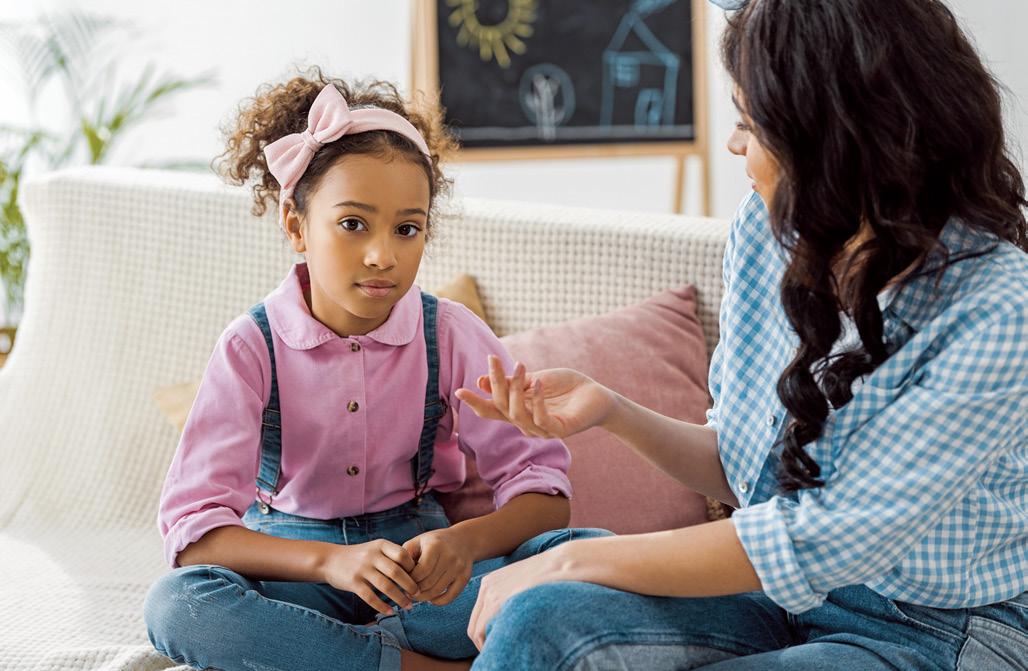
Mid-Elementary School:
feel like they are somehow to blame for how their parents are feeling. Sometimes though, circumstances would require the child to have some understanding of what is happening for their parent. This is especially true if they needed to stay with an extended family member temporarily during a parent’s treatment.
If a parent is struggling with mental health challenges, it is critically important to get help. It’s not only necessary for the parent’s wellness but also for the health of the family as a whole. An important part of treating mental illness is talk therapy and the therapist involved can help a parent navigate the disclosure
The first step is always to talk to your family doctor to see if there is any support available that would be covered by your provincial health care plan. Unfortunately, there are often long wait times for this help, and so if you do not have extended medical that covers psychotherapy, you may need to reach into your savings or ask for financial assistance from others to pay for the treatment you need. Until our governments recognize the value of providing coverage for most mental health services we need to find other ways to get what is needed to heal. As hard as it may be to spend or borrow the money required, this is not the time
Children at this age could manage knowing a little more. You could explain that you do not “feel well in your mind” or “in your heart.” It will still be very important to reassure them, be clear that this is not their fault in any way and explain that you are getting the best help available. Leave them with a feeling of hope that things will be better soon.
Older Elementary School & Middle Years:
Older kids could handle a name for what you are facing. You could say, “I have an illness called depression. It means that I have deep feelings of sadness inside me that I cannot shake off. It drains me of my energy and makes me want to sleep all the time. It is nobody’s fault. It is not my fault, and it is certainly not your fault!” Share with your child everything that you are doing to feel better and give them hope that things will be better soon.




This is the time to have the kind of conversation you may have been wanting to have with your child for a while. They could handle more detailed information. It’s generally an appropriate time to explain the medical basis for the mental illness. You can talk about genetic factors and environmental factors. You could explain in more depth the treatment you are receiving. You can give your children updates on how you’re doing and what your medical professionals are suggesting. You can also ask a child of this age for a little assistance. Ask them to help around the house. Ask them to go for walks with you. Allow them a sense of agency and give them a way to participate in the family’s goal of getting you better. This is also the time to talk to your adolescent children about any genetic risk factors they may have inherited and what to be on the lookout for in their own lives. Talk about what it means to practice good mental health care.
When the time is right, I would encourage you to bring the notion of advocacy into these discussions with your children. Discuss how your family can raise awareness about mental health and spread the message that the world needs to lose the stigma and focus on getting help to those who need it.

Finally, some parents find it helpful to keep a journal where they write to their child about what is happening for them during their illness, how they are feeling and how they are trying to get better. They save this journal and share with their children once they are adults. This can help the children understand what the parent was going through during a time when they were too young to hear the full story, and may even provide meaningful insight if they are struggling with mental health challenges of their own.
Dr. Jillian Roberts is a child psychologist, UVic professor and mother. She is the author of Kids, Sex and Screens: Raising Strong, Resilient Children in the Sexualized Digital Age and CEO and founder of MindKey Health mental health clinics with locations in Victoria, Sidney and soonto-be in the Western Communities. drjillianroberts.com
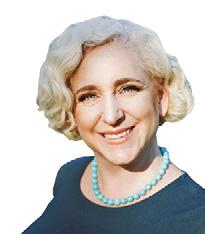
Ileave work early. I am excited and nervous for my son to play his first handball game at his school. It’s the first team sport that any of my children have participated in. My husband and I settle on the bench next to all the other parents. We’re ready to cheer.
Our principal, (who is also the coach) explains the spectating rules. I read three sets of approved encouraging words on the wall that are suggested cheers. One poster states: “Need more effort.” This phrase annoys me. Are we encouraging or offering negative connotation with this phrase? It is bordering on constructive criticism. Should parents cheering really be giving feedback as a coach would?
The game begins. I don’t know the rules, but we learn along with the kids about how many steps are permitted and pivoting. I embrace the positivity of “Good try” as my standard cheering words and clapping for both teams. There are also lots of “ohhhs” and “ahhhs” and “so close” yelled from all around us.
The game is intense. We are getting slaughtered. I learn we are playing against a Grade 5 team, but my son and his teammates are in Grade 4. They will only play Grade 5s due to a lack of coaches for Grade 4 teams. An extra challenge for our team. The other team is also much taller than our team and they are fast at intercepting throws.
Handball reminds me of basketball because opponents are
blocking you as you try to shoot. However, the net is lower and similar to a hockey or soccer net.
Oh no, the pressure. My son is suddenly in goal. That is a tough position. Some shots go in, but he looks like he is having fun. I’m nervous for him. I would not want that position, but this is not about me. I offer an encouraging smile when he looks my way. I guess the teammates all take turns in playing every position. That’s good.
As the ball reaches the back of the net again, the parent next to me snidely comments: “I think we need a new goalie.” I’m appalled. My son is in goal, but even if it wasn’t my son why would you say such a thing? Is this how some parent spectators get out of hand at children’s sports games?

I say nothing. I don’t like confrontation. My husband offers a supporting look in my direction. I decide once this parent realizes who my son is he will likely feel bad and that is enough for me. I continue to watch the game. My only comforting thought is that there is no way my son would have heard the comment over all his teammates and the opposing team shouting “I’m open,” and “Pass to me.”
It’s the last few minutes of the game. The score is discouragingly high for the other team. We have no goals. Some of our players can’t take their eyes off the scoreboard. They are distracted. They are not blocking their opponents anymore. I think they have given up. One player starts crying. I feel bad for that player. It’s an emotional rollercoaster playing sports.
None of this matters though. They are out there to have fun and exercise.



After the game, I tell my son the score does not matter. They are getting a great workout, learning how to pass the ball and learning about sportsmanship. My son can’t wait for the next game. I’m glad he has taken the whole game in stride. He lines up with a smile on his face and completes his elbow bump sportsmanship with each player on the opposing team. I’m excited for the next game too.
I think back to the only team sport that I played in elementary. I was on our 4 x 100m relay team. I was a nervous wreck. I ran too fast. I did not pass the baton in the passing zone. It was my fault our team was disqualified. I was devastated. I knew the rules, but in the moment and with the nerves, I was just too fast before the pass. My son knows this story and that it’s okay to make mistakes and fail.
My son’s team finishes the season with three goals in total. They were close to scoring goals many other times. More importantly, my son had fun. He played all the positions. His coaches were great. He even made each coach a bracelet and we wrote them each a thank you card. He enjoyed a great workout and improved his throwing and catching skills. He’s looking forward to playing again next year, and I am looking forward to watching. I feel I’ll be better prepared and ready to empathize with all the emotions that come along with sports too.
Serena Beck works full-time as a Technical Writer. She loves to write, travel and swim at the beach with family and friends.






“When is your Anniversary?”
I looked down at my daughter’s young friend wondering if I had heard her correctly. I asked her to repeat herself.



mered out “Well, we’re not technically married, so we don’t really have an anniversary.”
She looked confused.
“But if you’re not married, then how
“Your anniversary. When you and your husband were married.”
Yup, I had heard her correctly. Feeling a bit stunned that an eight-year-old was interested in such things, I stam -
did you have her?!” She motioned towards my daughter.
The already-awkward conversation became even more awkward as I wondered how much I was responsible for
telling her about how you didn’t need to have a marriage certificate to create a life.
“Well, um, you don’t have to be married to have a baby…” I managed to tell her, feeling my face becoming flushed.


The young girl still looked quite alarmed, and I could tell she was about to ask more questions I wasn’t at all prepared to answer. Thankfully a friend standing nearby picked up on the conversation and quickly interjected.




“Parents and families all look different,” she explained. “Not everyone is married, and some used to be married but aren’t any longer.”


And there it was. Parents and families all look different.

I’ll never know if that young girl went home and announced to her parents that her friend’s parents weren’t married, but I didn’t get any messages from them asking for clarification or saying she couldn’t hang out with my child any longer. I’m hoping if she did tell her parents, they explained that families come in all shapes and sizes.


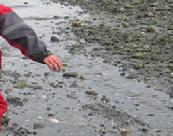

Because that’s the thing—over time, the definition of family has drastically shifted. Gone are the days of families consisting strictly of a married heterosexual couple and their children. Today it’s not uncommon for children to have two dads, two moms, or any other adult figure(s) raising them. Grandparents or other adults sometimes step in to raise children when the parents need help. And, as in our case, a growing number of couples choose not to get married before they start a family.
I grew up in the 1980s with divorced parents, as did almost half of my friends. Some of us had step-parents and step-siblings, while others lived with a single parent. I still see this reflected in some of my child’s friends, and I imagine I will see it even more as she gets older.
As house prices rise many people are choosing to have grandparents, other family members or even friends live with them. This then creates a whole new type of family.
The point is that a family certainly doesn’t have to be “traditional” to be considered a family. Families are made up of care and love, no matter the size or composition.


Erika Palmer is a writer living in Victoria with her husband and daughter. She believes most problems can be solved with a good cup of tea and a huge piece of chocolate.

Glenlyon Norfolk School is offering a variety of fun summer camps for students age 3 to 17. Arts, cooking, baking, field hockey, day camps, kayaking and more—our summer programs offer something for everyone!






These local businesses are family-focused and committed to our community and helping you.






Ipull the tape gun across the top of a box, hearing the sharp sound of the tape peeling from the rest of the roll. Another box, one of many. This one is filled with my son’s baby pictures. I exhale and think back to the specific photo shoot. Thinking ourselves artistic, we took macro snapshots of my son and stretched them across canvas: the curvature of a tiny ear, his mouth with baby fuzz above his lip, a tuft of nascent hair on his head. We used to call him “Kiwi.”
I realize in this moment, I will soon become a statistic. The “we” will inevitably dissipate and end in yet another divorced dad. Before that though, there is this peculiar period of pulling two people apart who were once so enmeshed. Moving vans, paper trails, lawyers, memories. The moment my five-year-old son stands frozen at his bedroom doorway, seeing his room in boxes. Dividing calendar years into weekson and weeks-off. What will Christmas look like? Birthdays?
My new role as a single dad would continue to feel uncomfortable, and things that were once simple would take on a new, stranger colour. I wanted to arrange playdates for




my young son but approaching married women when picking up my kid from school for this purpose felt clunky and unwelcome. Invites to parties became scarce. I had to adjust to a new kind of logistical communication with his mother. Clashing schedules. Trying to remember who had what. Meanwhile, the confusion on my child’s face was palpable, and I lacked the toddler verbiage to help him understand our new normal.

It took me three months of flying through different counselors until I eventually found one that gave me the tools I needed, and I used his array of coping mechanisms like the multi-tools in a Swiss Army Knife. His thoroughness and compassion mixed with his ability to disagree and question my thought processes was invaluable. When I leaned into my vulnerabilities, he enveloped me with kindness. I was grateful to employ these new tools, giving me more peace and clarity to figure out my life’s “whys?” To discover what is meant to be a dad. To be a human.
I devoured family-style podcasts and self-development articles. I went for long bike rides. I had lengthy, challenging conversations with myself. I was trying to figure out how to exist as a single dad.


My experience is far from unique. While my West Coast casual mentality likes to think the statistics are lower on this side of the country, I found that BC actually came in slightly higher for divorce rates at 39% of the population. Despite this whopping figure, I found that support and community for single men was sparse. After months of trying to find my new place in the world, I realized that I no longer wanted to go this alone. I needed an expanded community.
Since I struggled to find the support I was looking for, I endeavoured to create this myself. Luckily, I now find myself in a place where I have the time and ability to help change the status quo for men in a similar situation. Men who are looking to thrive in their new roles, with the ultimate goal of making huge strides in their kids’ lives. I know I don’t have the answers to a puzzle I myself am still putting together, but sometimes I’m lucky enough to share my story with others who have gone through a similar experience, and for them to share their stories with me.

A tribe works best when we uplift each other in our own journeys. We evolve through mutual understanding. I’m just a guy who supports some other guys going through it all, through ideas and collaboration. I’m at the start of exploring these new possibilities, and I know there is a need out there for dads struggling to find their place, their community, and just a little bit of support. This could be simply listening to your story and sitting in that space with you or figuring out ways I can offer some of the solutions that continue to help propel me forward.
Separation with kids involved can be scraggly, uncomfortable and precarious, but you’re not alone.


Michael Morrell is an empathetic father wanting to hear your story. Contact him at michaelrhmorrell@gmail.com.

airplanes, seaplanes, helicopters and more at the BC Aviation Museum



Learn about BC’s aviation history from early bush planes to bombers and beyond!
When I was a new mom, I lived on sandwiches. They were pretty much the only thing I had the time/energy/mental power to put together. And they always hit the spot.
Sandwiches are great for using up pantry staples. They’re always an option...even when you haven’t had time to go to the grocery store. Add some chopped-up vegetables and you’ve got a complete meal that didn’t take a lot of time to prepare. Perfect for on-the-go dinners. Something that I’m going to need to rely on as we roll around into baseball season!
Cold sandwiches are the stuff of lunchboxes. Here are four hot sandwiches that are quick to prepare and packed with protein.
When grilling sandwiches there are several options:
Under the broiler: Broil on high for 2–4 minutes on each side. Or if you don’t have time to watch over your sandwiches, broil on low for 5–8 minutes instead.
Sandwich maker/waffle iron: Sandwich makers were all the rage in the 1990s. Akin to the air-fryer today. If you happen to own one, they are definitely the EASIEST way to grill a sandwich.
Stovetop option: We don’t happen to have room for extra appliances in our tiny townhouse kitchen. So we make grilled sandwiches by heating a frying pan on medium. Then we place a cast iron pan on top to give it that pressed sandwich feel. Frying a sandwich takes 2–4 minutes on each side, depending on how hot your pan is.
Honestly, is there anything better than a grilled cheese sandwich? However, if you’re feeding a lot of people and don’t want to spend the time to make a bunch of individual grilled cheese sandwiches, cheese toasts are a good alternative. Children love them, and you can make a bunch at once.
Summer Hours, May 1 to Sept 30: 10am to 4pm, Thurs through Tues
Winter Hours, Oct 1 to Apr 30: 11am to 3pm, Thurs through Tues
For special days and events go to bcam.net.
Raid your pantry to make fancy cheese toast. Pull out whatever you’ve got and let everyone build their fancy toasts!
6 Slices of bread
3 Tbsp butter
11⁄2 cups of grated cheese
Fun toppings: chopped tomato, crispy bacon, thinly sliced onion, roasted red pepper, zucchini medallions, spinach, thinly sliced apple.
Butter each slice of bread on one side. Place the bread on a baking sheet, butter side up. Let everyone decorate their own toasts with whatever fun toppings they want. Then divide the cheese between the slices of bread. Broil for 2 to 4 minutes until the cheese browns.

This was my favorite as a kid. It’s a sweet treat as well as a protein-packed sandwich.
4 Slices of bread 2 Tbsp butter
1⁄4 cup of peanut butter 1 large banana, chopped into thin circles
1910
Make a peanut butter sandwich with bananas in it. If you want, you can add a bit more sweet- ness with a drizzle of honey or chocolate chips. Butter the outside of the sandwich to add flavour and prevent it from sticking to the grill. Grill for 2 to 4 minutes on each side, until the bread is toasted and the sandwiches are warmed through.
Fried egg sandwiches were my go-to when I was pregnant with my daughter. However, they can be a bit time-consuming to make if you’ve got a few people to feed. Here’s a recipe that allows you to make a bunch of egg sandwiches all at once.
These can be served open-faced like a cheese melt, however, I’ve written the recipes for a closed-faced grilled sandwich which is a bit more filling.

8 eggs
1⁄2 cup of milk
1⁄2 tsp salt & black pepper, to taste 1 Tbsp oil
8 Slices of bread
2 Tbsp mayonnaise
1 bunch of washed spinach
2 Tbsp butter
1 tomato
4 slices of cheddar cheese
Mix the eggs, milk, salt, and pepper in a large bowl. Heat the oil in a saucepan over medium-high. Add the egg mixture and place the lid on the pot. After about 2 minutes, stir the eggs with a spoon. If they have started to set, then continue stirring, scraping the spoon along the bottom of the pot until all the eggs are fully cooked. If the eggs haven’t started to set, put the lid back on and let them cook for another few minutes. Make egg sandwiches with mayonnaise, spinach, tomatoes, scrambled eggs, and cheese. Butter the outside of the sandwiches. Grill for 2 to 4 minutes on each side, until the bread is toasted and the cheese is melted.
Beans on toast are definitely a dish that inspires nostalgia. However, it’s a bit like KD, in that it never tastes quite as good as you remember. This recipe adds a bit more flavor and pizzazz to this simple dish.
1 medium onion

1 clove of garlic
6 Slices of bread
1 red pepper
1 Tbsp oil


2 Tbsp butter

1 can of baked beans in tomato sauce (14 oz)
1 cup of grated mozzarella
Finely slice the onion and red pepper. Mince the garlic. Saute the vegetables in a small frying pan on medium-high heat until soft, about 5 minutes. Butter each slice of bread on one side and lay them out on a baking sheet, butter side up. Divide the baked beans among the slices of bread. Add a large forkful of the cooked vegetables on top of the baked beans, then top with grated cheese. Broil on high for 2 to 4 min- utes until the cheese is melted and starting to brown.
Emillie Parrish loves having adventures with her two busy children. You can find more of her recipes in her recently released cookbook Fermenting Made Simple. fermentingforfoodies.com


As a frustrated eight-year old, I remember writing a poem called “when I am nine” that described all the many possibilities the world would have to offer me when I was just a little bit older—old enough to get my ears pierced was the main one—but also, old enough to stay up later, old enough to have more friends over for my birthday party, not quite old enough to babysit yet but old enough to start thinking about the coveted Saint John Ambulance course.
Now, of course, growing older has less appeal, and with a milestone birthday approaching I’m realizing that the second half of my life will be quite different from the first. Ahead of me are inevitable life events, ones I am fortunate not to have experienced yet: my parents passing, health problems, my hair going grey. And yet, I realize that for the rest of my life I will look back at myself now and wish I was that young again. As one friend put it, growing older is a gift, or, as my grandmother always used to say, it’s better than the alternative.
The other day I went to a new hairdresser.
I’m not for everyone, he warned me. Then he proceeded to tell me that my hair was “losing pigmentation.”
Yeah, you’ll have a big grey streak here, he noted matter-a-factly as he combed through my part. I texted my What’s App mom friend group after the appointment to vent. Everyone chimed in how they were starting to get greys too. When I mentioned it to my Pilates teacher, she simply stated well, that is what happens as we get older as if expecting anything else just didn’t make sense.
My daughter is starting kindergarten soon and one of the things I’ll have to grapple with in the second half of my life is her growing up. Life as I’ve known it for the past few years is ending and in its place is a new life with an older child, one who talks and wipes her own bum and doesn’t need a highchair or soft food or sleep sacs or Baby Yum Yums. At soccer, she now kicks the ball instead of just running over it. She can sit through plays and go hiking without a carrier. Although there’s still the occasional tantrum, she more often negoti-

ates with the prowess of a Bay Street lawyer.
Recently, we went on a plane for the first time since the pandemic. It was the first time in my daughter’s memory. She got scared of the small bathrooms and didn’t go the entire time. As we landed, she started crying because her ears hurt and she had refused to suck on the candy we’d given her. After we landed back home, I tried to comfort her by telling her what a great traveller she’d been. You know, the plane is the worst part of travelling—it’s being in other places that’s really fun and seeing different people. She looked at me and countered but the plane was the best part!
It was then that I realized how many more wonderful things are ahead of me in this next decade. I’ll have a not-solittle child who just enthused about flying minutes after wailing from ear pain and not peeing for hours. She dances in the living room and makes cards to give to everyone she meets. We can go camping without hauling a pack and play and sippy cups. We can sit in coffee shops without running after her the whole time. Soon, she’ll have sleepovers
in our rec room and have crushes and play in real soccer games. We can learn about stars and make models of the solar system. Eventually, she can get her ears pierced and we can get pedicures together. Maybe she’ll even make me pancakes. She looks forward to getting older too—being able to read soon, using a real computer, being a cool “big kid.”
It’s time I start seeing the bright side as well. Life might be different with a few grey hairs, but it’s also the start of a new era. A different season of parenting. Although I may already have my ears pierced and be well past the babysitting stage, I also have a lot to look forward to as well—regardless of the ticking of time.
Julia Mais is a policy and communications professional in Victoria. She looks for beauty in the everyday through writing, photography and the outdoors. She lives in a messy, cheesefilled home with her husband and preschooler.



Come experience a new sport or activity, and for those that have serious athletic goals enjoy the opportunity of working with some of our world class coaches.
RUGBY
GIRLS ONLY ICE HOCKEY
BOYS ICE HOCKEY
BASKETBALL

SQUASH
FIELD HOCKEY
MULTI RACKET SPORT — TENNIS, PICKLE BALL & SQUASH
FIGURE SKATING


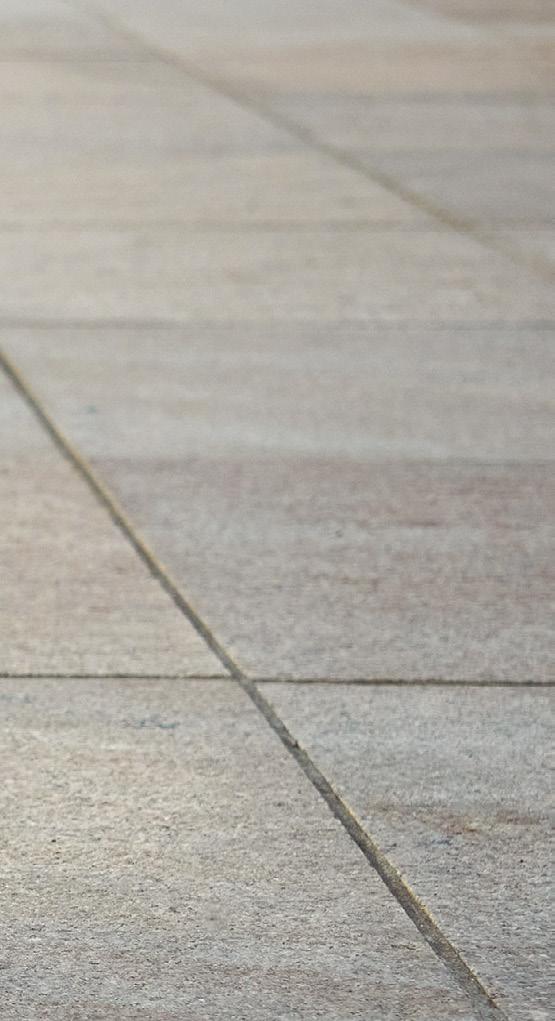
YOGA & DANCE
ELEMENTARY SCHOOL AGED
GROWING DOME ORGANIC GARDENING
REGISTER TODAY SHAWNIGAN.CA/SUMMERCAMPS

The Family Resource Directory is designed to highlight the caring community that we are a part of. This directory showcases organizations and businesses that provide services and support for families and children.
If you’ve looked at a calendar recently, you might’ve noticed that Mother’s Day is creeping up on us quite quickly. In honour of that special day, let’s focus on the women who inspire us, from those who know who they are and what they want to be, to those who are still figuring that out. No matter which mother-like figure you’re celebrating or remembering this month, I hope you and your children find these women inspirational too.
Navigate is an award-winning school, recognized nationally and internationally for our innovative approach to blended learning. We’ve implemented the new BC curriculum and built unique, flexible learning options for every student. This allows us to meet a diverse range of student needs, abilities and learning styles.
Discover more at NavigateNIDES.com

Thriving Roots provides hands-on, wilderness education and counselling services for youth and adults. Our year-long programs and summer camps are immersive in nature, fostering connection to land and community through earth-based skills, play, music and more. thrivingroots.org info@thrivingroots.org
Anne and Her Tower of Giraffes by Karlin Gray and illustrated by Aparna Varma (Kids Can Press, 2022) explores the story of Dr. Anne Innis Dagg, who was the first Western individual to study wild animal behaviour. Anne adored giraffes. She wanted to know everything there was to know about them. But Anne had a problem. There wasn’t a lot of information known about giraffes when she was growing up. So, she decided to study them for herself.
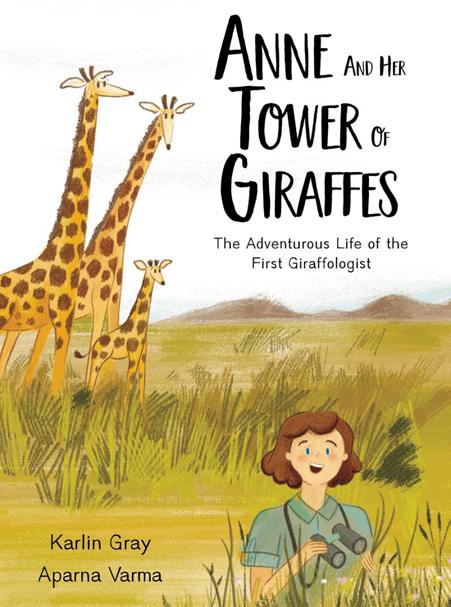
The delightful and warm illustrations, breathe life into this beautifully written biography. And if you have a budding giraffologist in your life, the book also contains a Q&A with Anne as well as some additional resources for you to explore. For ages 4 to 7.
A Person Can Be… by Kerri Kokias and illustrated by Carey Sookocheff (Kids Can Press, 2022) highlights how hard it can be to figure out who we are. So often we are labeled as one thing or the other, but A Person Can Be… reminds us that we can be both. In this story, where the illustrations tell a story all their own, we learn we can be brave and afraid. We can be lonely and not on our own. We can be this and that, it doesn’t have to be one or the other. For ages 4 to 7.

The International Day of the Girl by Jessica Dee Humphreys and the Hon. Rona Ambrose and illustrated by Simone Shin (Kids Can Press, 2020) celebrates nine girls from around the world who have stood up in their own unique ways,

from getting a school built in Northern Canada to making communities safer in Russia and refugee camps. For ages 8 to 12.

Walking for Water by Susan Hughes and illustrated by Nicole Miles (Kids Can Press, 2021) is about a thirteen-yearold boy who noticed that his twin sister stopped going to school because she was needed at home to help out with all of the chores. That didn’t feel right to him so he decided to do something about it and help out even though it was weird and unusual for a boy to collect the wa-


ter. This is a beautiful story about equality and sibling love. For ages 4 to 7.
Her Epic Adventures: 25 Daring Women who Inspire a Life Less Ordinary by Julia De Laurentiis Johnston and illustrated by Salini Perera (Kids Can Press, 2021) features 25 snapshots of different women who have done incredible things from Bessie Coleman, the first Black aviatrix, to In-Young Ahn, the first South Korean woman to conduct research in Antartica, to Arunima Sinha, the first female amputee to climb Mount Ever-

est. Each of these well researched tales sheds a bit of light into some phenomenal woman to inspire your kids to live lives that are less ordinary. For ages 8 to 12.

Between these five books, there are more than 30 women (and a few men) that are worth celebrating any month of the year. Maybe you don’t think the special woman in your child’s life is as inspiring or noteworthy as the women on this list. But to expand on Kokias and Sookocheff’s idea: you can be anonymous and known, and you can be “imperfect and treasured.” And so, I hope you have a wonderful Mother’s Day no matter who you choose to celebrate.
Christina Van Starkenburg lives in Victoria with her husband, children and cat. She is the author of One Tiny Turtle: A Story You Can Colour and many articles. To read more of her work and learn about her upcoming books visit christinavanstarkenburg.com. Facebook: facebook.com/christinavanstarkenburg and Twitter: @Christina_VanS.

“Most big ideas don’t seem like big ideas at first. So, be on the lookout for little ones that seem kind of hohum, let-me-floss-first kind of ideas.”
I saved this quote, but sadly not the attribution. I love it.
Years ago, I heard about a program in Canada and the U.S. that brought young kids to read to shelter cats—a reciprocal program to serve emerging readers and emerging adoptees! It inspired me to launch a similar pilot project last spring.
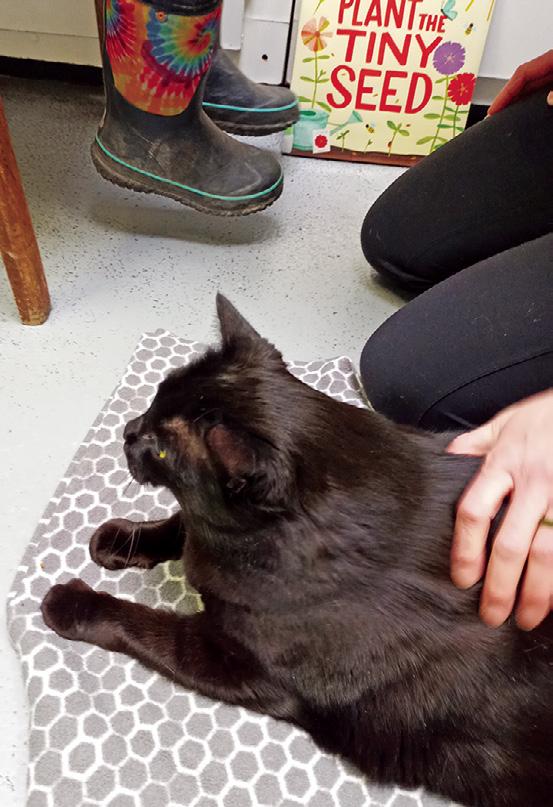

I reached out to the local Victoria SPCA branch. “Can I bring kids a few times a month to read to cats?” They said, “Yes!”
At EPIC, a founding principle is to address disconnection from the self, others and the living world. It’s a significant step to reconcile some of the root causes of our climate emergency and ecological collapse. School is also a wounding place for kids. The classroom often lacks the emotional safety kids require to be at rest, free from alarm. If you’re alarmed, you cannot learn.
Kids are under great pressure to read by certain age, from a one size fits all formula. The pressure to read— from parents, peers and teachers—can put its unfolding on pause. The child also adds their own pressure to perform. It may explain, a genre of children’s books called “Reluctant Reader.” What an unfortunate and defeating label.
The benefits of reading to cats for the kids is they can read aloud free from correction, minus judgement from their peers, and take a break from what doesn’t work at school. Many children took this task on as their job! “I must read to this cat” one child announced. Kids 5 to 10 years old brought in board books, picture books, chapter books and novels. They also read books about cat behaviour, cat breeds and wild felines.
energy, how to read body language and what they eat.
Benefits to the animals were a calm, quiet presence in child form. Cats felt a friendly stroke or scratch in an unfamiliar place, a cozy lap to call their own or someone to meet their play energy! Being in the company of kids tells staff more about the animals’ personalities. This can make them more adoptable. A true opportunity for cat enrichment.
Side effects of this humble program has children connecting to more sources of energy and love to support them. They discover animals are great listeners. Kids could also be themselves and feel unconditional acceptance. A few participants became foster families or pet owners, too. Surprise!
You can also create better ways to be in this world together. Help kids see themselves as part of something bigger.
I recommend:
Reach out to your local animal shelter. Visit the space to see what its looks and feels like.
Ask the shelter the best day and time to visit.
The world is coming undone. Experiences of suffering and challenges to the human spirit are on the rise. It’s led me to embark on projects, initiatives, and volunteering that I can’t not do. As a co-founder of EPIC nature school in Victoria, for K–Grade 5, I knew this pilot project could benefit youth and animals in search of their fur-ever home.
Kids get a cozy room with one cat and take turns meeting various cat personalities. Some are playful kittens, others quiet seniors and many required space and time to warm up. There are options to read in outdoor “catio,” a room with a couple of cats and outside of dog kennels, too. Kids also sat in or out of a bunny enclosure.
Children (and their parents) signed up because the program sounds fun and unusual. Often families had allergies in the home and couldn’t be pet owners. Children also learned about animal care—from bunnies to skinny pigs to dogs and rats—like the benefits of calm
Take small groups of five kids.


Read to pets at home!

I arrange visits based on what works best for the shelter and when I can supervise. I always bring a variety of books, too. Parents are often eager to attend. I choose professional development days, after school or on a holiday. Invite kids from your school, neighbourhood, local Girl Guides or Scouts or home learning community.
Highlights this year include seeing kittens only a few hours old, watching animals heal from an injury, celebrating adoptions and petting skinny pigs (AKA hairless Guinea Pigs)! Each visit is like opening a well-wrapped present. We never know who we’ll meet.
I am grateful for this partnership with the Victoria branch of the SPCA. Time spent in relationship with non-human kin is fundamental to human wellbeing. It’s uplifting to support kids to reach their potential. You’ll witness generosity and compassion for themselves and community, too.
Lindsay Coulter is a writer, educator, facilitator, naturalist, community catalyst, soul activist, mentor, and dedicated mother of two. She’s the Director of Communications, Culture and Community at EPIC Learning Centre, a forest and nature school in Victoria. Find her @SaneAction on Instagram and Facebook.
July–Aug 2023
Campers will explore the life of pollinators, shoreline plants, inter-tidal special and coastal birds, practice their discovery skills, expression of gratitude and respect for self and others through play!
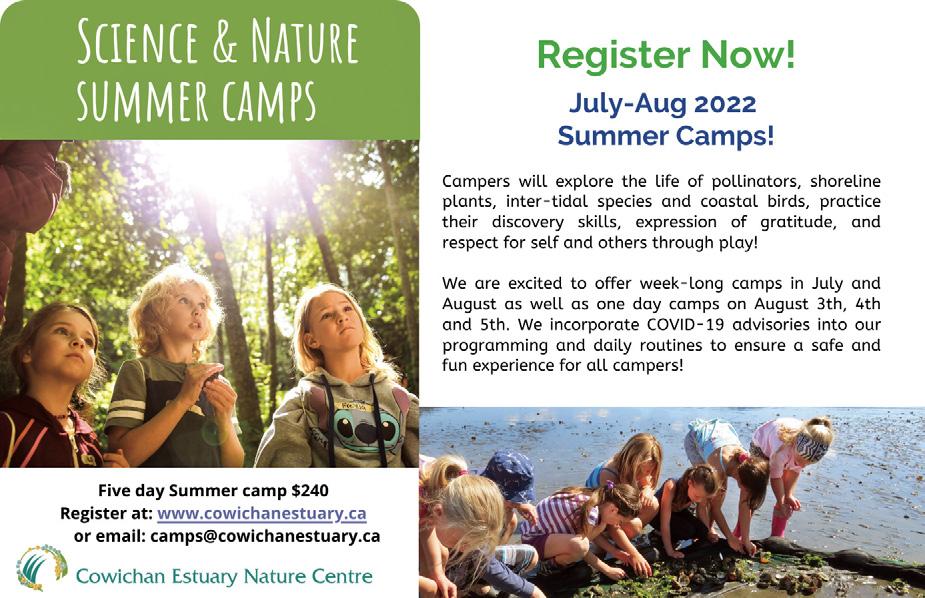
We are escited to offer week-long camps in July and August as well as one-day camps on August 8th, 9th, 10th and 11th. We incorporate COVID-19 advisories into our programming and daily routines to ensure a safe and fun experience for all campers.

Join CRD Regional parks naturalists this Earth Day (April 22) from 11–2 at the Elk/Beaver Lake Regional Park Nature Centre (at Beaver Beach). You’ll be guided through fascinating exhibits, displays and various activities suitable for all ages. Guided walks will introduce your family to the incredible nature and animals that make up our beautiful parks. crd.bc.ca/parks


Over 60 students from grades 4 through 11 from St John’s Academy Shawnigan Lake are excited to perform Frozen Jr. for the residents of Cowichan Valley at the Cowichan Performing Arts Centre on April 21 and 22. Revisit Elsa, Anna and the rest of Arendelle in this show for all ages! Tickets available now.

cowichanpac.ca/event/frozen-jr-02
This Earth Day (April 22) join the Regional District of Nanaimo Parks and Recreation at Moorecroft Regional Park in Nanoose from 11–2 for a family day filled with fun. Families will learn about the biodiversity of the park and how they can help to protect the earth with science games, art projects and nature exploration hikes. rdn.bc.ca/recreation
On Saturday, April 1 visit the Courtenay Museum between 11–2 to celebrate Spring and Easter in the Comox Valley. This family friendly event will include many different activities, prizes, a dinosaur egg hunt, fun kids crafts and even a petting zoo with chicks, rabbits, ducklings, hedgehogs and more! Admission by donation. courtenaymuseum.ca/events/spring-fling-and-easter-things

for
Victoria & Gulf Islands: 250-382-7000
Sooke: 250-642-5152 ext 239 West Shore: 250-940-4882

Cowichan Valley: 250-746-4135 local 231
PacificCare (Ladysmith North): 250-756-2022 or 1-888-480-2273



v Comprehensive programs for Preschool through Grade 11 v Delivering academic excellence through music, dance, drama and visual arts v Outstanding educators, locations and facilities Pre-School
PacificChristian.ca
250-479-4532
Where nature becomes the Teacher!

Seedlings Forest Education is a Nature based program that includes After School Care, Nature Preschool, Parent Workshops, Saturday Seedlings, Summer Camps and more! 250-880-0660 seedlingsforesteducation.com
www.ArtsCalibre.ca 250.382.3533
Christ Church Cathedral Childcare & Jr. Kindergarten ................. 250-383-5132
ECE and specialist teachers provide an outstanding all day licensed program for 2.5–5 year olds at our Fairfield and Gordon Head locations. cathedralschool.ca


Licensed child care facility with spots available for children aged 3-5 years. Contact us to book a tour today! Victoria Social Innovation Centre: 1004 North Park St littlephoenixchildcare.ca



Nestled on 4 acres of lush west coast forest, our Award winning, Nature based program will not disappoint!

While firmly embracing the Reggio-Emila (Italy) Philosophy our dedicated team of educators use the environment as the third teacher as we encourage your child throughout their day.
Our purpose built facilities have been handmade using the trees from our forest. Come take a virtual tour on our website! lexieslittlebears.ca Waitlist: 250-590-3603

BC Award of Excellence in Childcare & Prime Minister’s Award of Excellence in Early Childhood Education.
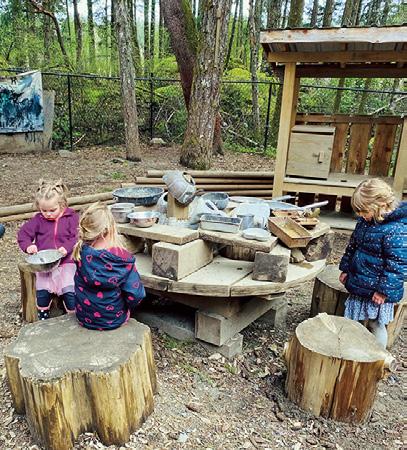

Being a busy parent is no easy feat, especially in today’s society where the cost of living is high and everything seems to be available at the touch of a button. It’s essential to teach our kids about realistic expectations and the value of hard work in this fast-paced world to
that things cost money, and it’s necessary to prioritize our needs and wants to make sure we can afford what we need.
2. Teach them about delayed gratification: It’s easy for kids to want everything they see, but it’s crucial to teach them the
differentiate between needs and wants and to make responsible financial decisions.
4. Encourage them to earn their own money: Teach your kids that money is earned, not just given. Encourage them to take on small jobs around the house or in the neighborhood to earn money. This will teach them the value of hard work and help them appreciate the things they have.
5. Set realistic expectations: It’s important to set realistic expectations for your children. Teach them that success takes time and hard work, and that instant gratification is not always possible. Encourage them to work hard towards their goals and celebrate their successes along the way.
6. Emphasize the importance of education: Education is essential in today’s society. Encourage your children to study hard and pursue their dreams. Show them that education is the key to unlocking opportunities and achieving their goals.
7. Teach them to give back: Finally, teach your children the value of giving back. Encourage them to volunteer and help others in need. This will help them develop a sense of empathy and gratitude and appreciate the things they have.
help them become the wonderful adults we hope for them to be one day.
Here are a few tips to help you get started:
1. Start with the basics: Talk to your children about the cost of living and why it’s essential to budget and save. Explain
value of waiting and saving up for things they want. Explain that sometimes we have to wait and work hard to get what we want, but it’s worth it in the end.
3. Lead by example: Children learn by observing their parents. Show them the importance of budgeting, saving, and living within your means. Teach them to
Any mindful step you take in the direction you want your children to follow will reap benefits. Our world needs people with a strong work ethic, financial responsibility and appreciation for the things they have—and you are raising them!
Lindsay Plumb is an Accredited Financial Counsellor (Canada) and founder of Pretty Money Club, Black Is the New Red and MOOLA Financial Coaches & Advisors.


Igrew up with a lot of shibboleths and thou shalt nots. Thou shalt not make a mess, thou shalt not make a peep, thou shalt not reach for another cookie, thou shalt not say “love” when talking about food, thou shalt not question the conventional wisdom or upset the status quo.
My husband and I wrote anarchist songs, Brown Bag Blues, and toured a show called Jabber Disease. We brought on “Thou shalt!” in poem and song, paeans to seven beautiful virtues.
Pride is a goodie. Watch any kitty when she catches herself in the mirror,
Thou shalt not was a tune with infinite variations. In church, where we were washed in the blood of the lamb, which turned out to be propaganda, they preached the Seven Deadly Sins and my life ambition turned out to be turning sin into mindful practice.
They say suppression invites subversion. I fancied myself a subversive and got arrested a few times. Call me arrested mother, grandmother and great grandmother. I’m still getting busted.

a window. Yikes. Is that me or a more formidable she? Babies smile in the mirror and that is before they hear they are too smart or not smart enough, too ugly or too beautiful. I love you, we say. Keep smiling. Draw yourself over and over. Paint yourself proud. Colour your world. Greed is gathering. We make picture after picture of images we love. We gather friends when we play in the park near our house, say “Hello friend!” to every new face. We gather berries to cook and

shells to paint. We gather music. Every last thing makes a sound and we listen, greedy for birdsong and, ocean wailing, footsteps drumming sidewalks, all notes for our scores. Soundwalks are great. Is this greed? If so, bring it on.
Wrath is war on bullies. Whoever said righteous indignation is bad? When is a wrong not a wrong? Get mad at the window that smacked the sparrow. Get mad at the thug smacking a smaller kid. There are bad guys and good guys. Fairy tales tell us that, and kids need to know how to deal with oppression. Read the stories that tell us to love ourselves, be bigger, set an example. Get mad and use our words. Rage at the bad stories on TV and man and woman up for warriordom. Fight for clean air and clean water, for peace.
Lust is hunger for knowledge. Aren’t we hungry all the time, for truth and beauty. Lust drives us to smell the flowers, collect leaves, read books, climb trees so we can see forever. Some kids like small collections that fit in their pockets. Sometimes we go for walks and gather.
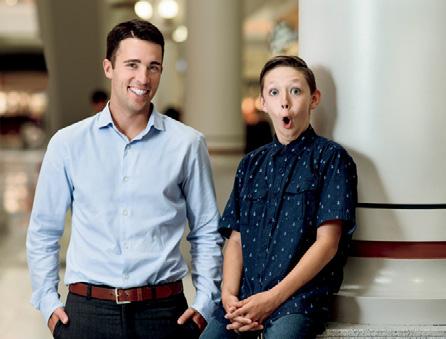


What is this pebble, this egg, this caterpillar (be gentle) this moss, this bug? Every last thing has a story, a life. We gather people too. Safe strangers are fun. Sometimes they tell you their stories and sometimes it’s fun to guess.
Envy is admiration. We listen to music and copy the sounds. We look at art and aspire to paint. We dance to the rhythms in poetry. We envy the sunset for its’ beautiful regret and sunrise for its’ promise. We want to be the light. That is the meaning of genius, joining the envious “I” to the “Us” so we are one, all moving parts in the great circle of life. Look at this, look at that, we say. Choose the best parts, the ones that fit with our mandate to be the best us.
Gluttony. Do cookies ever taste as good as batter? We take, then bake, our bellies filled before we load the oven: bread dough, whole bowls of berries, spoonfuls of honey. Food is for pleasure and for life. Who said we shouldn’t love it? Be greedy, little ones, and take enough to share, all our fingers in the same pie, because everyone deserves a taste. We
decorate brown paper bags, ride the bus downtown and give happy lunches, all our pleasures combined in one joyful afternoon.


And most important of all is sloth, the pure joy of rest, doing nothing but breathe and dream. First, we find a soft bed of grass or moss, clover if we’re lucky, then we lie down to experience the luxury of rainbows or starry nights. We look up and watch the shapes of our ancestors playing hide and go seek with future kids through clouds as fleecy as the sheep we count on our way to sleep.
Of all the deadly sins, sloth is the most pleasant because S is for satiation when we fill ourselves with sunshine and story.
Sin away kids. Thou shalt! We’re a big club. Everyone welcome. Grammalinda’s got your back.


 Linda Rogers is a poet, novelist, essayist, journalist, editor and songwriter.
Linda Rogers is a poet, novelist, essayist, journalist, editor and songwriter.
Ihave just had the immense pleasure of meeting my first grandchild! He is such a delicious little blob of goo. So soft and warm. I have always loved babies and am happy to cuddle any baby at all. But my own son’s baby feels very special indeed.

My daughter-in-law, Chloë, and my son, Simon, who live in Ontario, were very conscientious in curating a wishlist for their baby shower. So I thought I would share some of those items the new parents liked the best and found the most useful. And I have added some of my favourites, too.
Chloë absolutely loves this. She says it’s super clutch to have a shallow bas-
sinet where the baby can sleep in the living room, and where they can change a quick diaper. Later it will convert to a deeper playard which can fold up and come along on trips to friends’ houses. I like that it’s got wooden legs— makes it feels like furniture instead of camping equipment. And it’s very light and easy to set up; I was able to do it with no trouble. maxicosi.com/ca-en/ swift-playard-05430-mc-ca-en.html
Simon is so impressed with the Diaper Service they are using in Ontario. He very much wanted to use cloth diapers, but they live in an apartment with coin-operated laundry. So washing their own diapers is a difficult proposition.
The Diaper Service delivers clean diapers every week and take the dirty ones away. Diaper service is comparable in price to using disposables, but it’s better for the environment.
My mother, the baby’s Great Grandmother, is paying for the diaper service for the first few months. It makes her feel very useful! happyislanddiapers. com
Very compact, the Yoyo2 folds up in a snap to the size of a carry-on suitcase. Light enough for Chloë to lug up to their 3rd floor walk-up. There are several attachments for it: a bassinet for new babies, clips for the car-seat, a yoyo-board for the big-sibling when the next baby
comes, even skis for deep snow! It’s steady, with a low centre of gravity, but easily manoeuvrable. It’s quite pricey, but several households pitched in at the baby shower and it seems to have been well worth it! babyzen.com/pages/ yoyo2-stroller-birth
(Simon and Chloë recommend consulting this comparison chart on Reddit: reddit.com/r/beyondthebump/comments/z2qwrs/comparison_of_travel_ strollers_details_in_the)
This backpack comes in many colours. Trim and compact, with many separate compartments and a changing pad. Will need an extra wetbag if parents are using cloth diapers, but that’s easy enough to get (see #5). Both parents agreed they could carry this bag with confidence. So stylish that Simon’s fashionista Great-Aunt was happy to select it for the baby shower. westcoastkids.ca/settlement-sprout
Colibri is a Manitoba company with wetbags in a whole raft of sizes, colours and patterns. Good quality at a great price. Wetbags are useful for so much more than wet diapers. Bathing suits, toiletries, snacks, sandwiches. A great parenting hack! colibricanada.com/collections/regular-wet-bags
This Canadian company makes soft and stretchy sustainable bamboo fabric wraps, just over in Vancouver! While learning to use a baby wrap might seem scary, it’s really no more complicated than tying your shoelaces. Simon learned in an afternoon and loves to wear the baby around the house and out on walks in the neighbourhood. It really is the cosiest, easiest way to keep a baby soothed, while getting chores done, and a great way for parents to bond with the baby. belugababy.ca
This is a brilliant idea, invented by a Dad in Montreal. It’s a panel that zips into most jackets to create space first for the growing pregnancy tummy, and later for the baby in a wrap or carrier. It has a removable fleece layer for colder climates. A really thoughtful gift that Chloe used all winter. And Simon can use it when he baby-wears too! makemybellyfit.com/products/universaljacket-extender
As Chloë said, this was clutch in the early days when baby needed to be swaddled to be comfortable but the parents were still figuring things out. Later, when the baby can roll over, you can open the sleeve holes so baby’s arms can be free. Being swaddled helps baby calm down because of the slight pressure on their body. And it also keeps them warm and cosy through the night. The ErgoPouch was invented by an Australian mom—Alina Sack! ergopouch. com/products/pouches
I loved dressing my own babies in baby nightgowns. Not only did they look so cute and old-fashioned, but the nightgowns were so easy to pull up for diaper-changes in the dark. And no need to thread legs back into pants, or snap fasteners with sleepy fingers. The organic cotton gowns (and all sorts of other baby clothes) from Parade come in lots of colours and patterns, including a wide selection of genderneutral ones. And the cotton jersey is thick and warm and holds up to many many washes.
When I found out Chloë and Simon had not received any little gowns at the shower, I sent a batch of these off to them. They use them all the time. parade.ca/collections/organic-baby-gowns
So pretty with their flowery pattern (and there are many other patterns to choose from), but also thick and absorbent to catch baby spit-up. A lower price-point item, always good to include on a baby shower wish-list. copperpearl.com/products/premium-burpcloths-bloom
Bonus Item
Really more of an “Oh Wow you’re pregnant!” gift: A is for Advice (The Reassuring Kind): Wisdom for Pregnancy by Ilana Stanger-Ross. Ilana is a Registered Midwife in Victoria. Her book is full of up-to-date, evidence-based, gentle information and advice for pregnant parents. It’s wonderfully comforting and beautifully designed with great illustrations. I send it off (via bookstores on the internet) to anyone in my circle who gets pregnant. And they all love it.
Being a grandparent is full of surprises and joys. I didn’t expect to feel so moved by seeing my son parent his baby so sweetly. I never thought about how I would feel to see my parents hold their first great-grandchild. I think that was a high point in my life.
With Simon and Chloë and the little one living so far away, I am going to be a Zoom-Ma, who checks in via the computer screen on the weekend. I will miss a lot, I know. But I certainly can engage in one of the time-honoured joys of grandparenting—shopping for the baby! Enjoy!
Eva Bild is a childbirth, parenting and lactation educator and doula trainer. She has been working with new families since 1992. Eva is the founder of the Mothering Touch Centre. She is the mother of three wonderful adults, but most excitingly, she is now a grandmother! evabild.ca

My daughter is growing into her role of mother with grace, wisdom and patience. Yes, I know I’m biased, but it is a remarkable thing to witness. I believe this to be one of the most meaningful experiences of my lifetime along with being a parent myself. The determination that could bring me to my knees when I was her mother is one of her greatest gifts as a mother herself. It provides her with the strength to make decisions based on her beliefs and values.
I have which tends to be an hour or two, here or there, a few times a week. We check in with each other. Am I asking too much, I know you have your own life, Mom. Or, are you wanting some company or have you got plans?
Other boundaries include the role we play in our relationships. While I have taught parenting for decades, I am not my daughter’s parenting expert. I’m her mom, the only woman on the planet who can be her mom. Imagine how allergic she would feel to my advice if it was unsolicited and coming from judgment or wanting to teach her how to be a better parent. Fortunately, my own mom modelled this boundary for me. She stood back, respected my choices, and didn’t interfere with our parenting.
I’m grateful that there is so much information available to parents now. More than that, I’m grateful that my daughter beats to her own heart. She doesn’t buy into some of the theories that suggest you can spoil children by responding to their needs.

These questions are asked by both parents and grandparents: How do we have serious or difficult conversations when we see things differently? What would be an issue that I would feel compelled to discuss? What are the important points of parenting that I would want to share? If I see or hear something that concerns me, what is my belief? What is important about this issue? What is the need or value that it represents?
If the statement doesn’t land, stop talking. Go slow so that you have time to feel things out and to listen to the response. Get curious.
If what you say is making sense and well received express gratitude. I appreciate our ability to talk about these things. Remind your child that we learn as we go, and we are all doing our best.
We tend to repeat what we learned in our own families growing up when it comes to boundaries. If we are fortunate, healthy boundaries come easily. If the boundaries were blurred we may have some blind spots yet, we can educate ourselves and develop our awareness.
As parents, we learn through our successes and failures. We don’t have all the answers up front. We gather knowledge day to day by looking back if something didn’t go well or if we are feeling guilty. Boundaries that matter usually represent respect for time, privacy, emotional and physical safety, people’s autonomy, and the need to belong and be loved.
I remember very clearly, two times that my mother spoke up. Once, when my daughter was four and I was sick with the flu. My daughter was climbing all over me and not letting me sleep. I said something awful like, if you keep waking me up, I’m going to get sicker. With that, my mother spoke sternly and said, she doesn’t need that kind of responsibility for your health.
There are many boundaries to consider between parents and grandparents. How much time do we give or ask for when it comes to babysitting? Or, as a grandparent, when are you stretching yourself too much? I see a reluctance in my daughter to ask me to babysit while she teaches yoga or goes to an appointment if it is outside of my usual Nana Day. So, I make a point of checking in any spare moment
A recipe for bringing things up: Choose a time to talk when there are no distractions or children present. Ask permission. Would you be comfortable with me stating a concern?
Stick to the facts, not what you think but what you can specifically observe. When I hear or see __________. And state what need or value you are concerned about.
Watch your body language. Your adult child may be exhausted, uncertain and already riddled with feelings of guilt. Have a soft face and a gentle tone.

The second incident came years later when she was in her late 80s. I started going to her apartment to clean it. I was on my knees cleaning her toilet bowl. Standing behind me, I heard her say, Dr. Rees! I can hire a cleaner, I just want you to be my daughter.
With a loving connection, and healthy boundaries we can navigate those invisible lines. We can create what works for everyone and enjoy loving and being loved.
TRavel

to snowy forests, scorched savannaH and the darkest depths of the ocean, and meet animals all over the globe.











